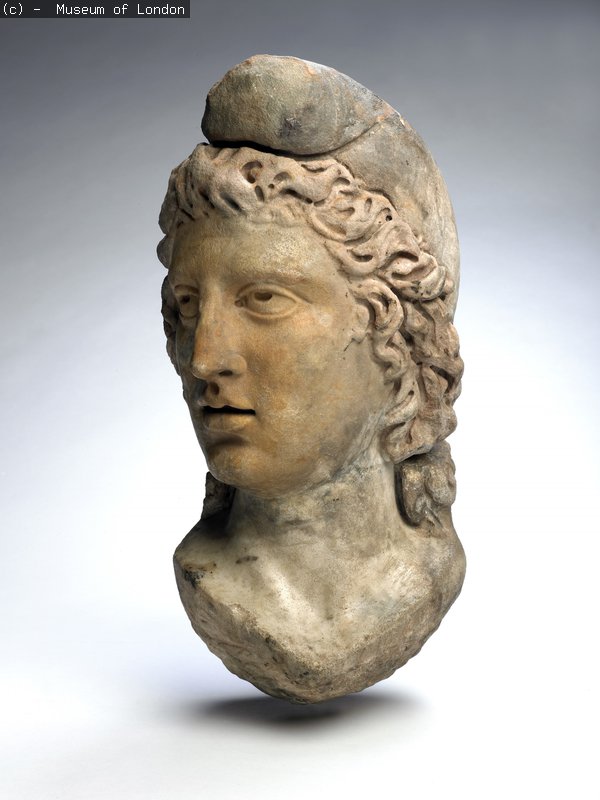UK’s most significant Mithras collections come together for rare display at the Great North Museum
"...once in a lifetime chance to see two internationally important Roman Mithras collections side by side"

A new display at Newcastle University’s Great North Museum: Hancock will feature high-profile loans from the Museum of London to illuminate the story of one of the Roman Empire’s most enigmatic gods.
Mithras: Roman Religion from Thames to Tyne runs from Saturday 1 July to Sunday 27 August. It brings together for the first time objects found in the 1950s during excavations of two important temples to the god Mithras, at Carrawburgh on Hadrian’s Wall and Walbrook in London.
The Carrawburgh finds – owned by the Society of Antiquaries of Newcastle upon Tyne and on show in the Great North Museum: Hancock – include three altars to Mithras as well as sculptures and religious utensils.
They are joined by three exquisite marble heads of Mithras, Minerva and Serapis found at Walbrook, and a sketch reconstruction of the interior of Carrawburgh temple by artist Alan Sorrell.
Caroline McDonald, Manager at the Great North Museum: Hancock, said:
“This is a once in a lifetime chance for anyone interested in archaeology to see these two internationally important Roman Mithras collections side by side. It’s never happened before and is not to be missed.
“I’m thrilled that we’ve been able to work with the Museum of London, my home for many years, on making this display a reality.”
Mithras was an ancient Persian god adopted in the Roman Empire as the main deity of a mystery religion that flourished in the 2nd and 3rd centuries AD. The religion was open only to men and some scholars believe its worshippers were highly secretive about their rituals and beliefs.
Mithras was both a sun god and a creator god. Iconography found in his temples often focuses on the act of creation in which Mithras kills a bull and life – in the form of ears of wheat – emerges from the slain animal’s tail.
The god is frequently depicted as being born of a rock or egg, and the Great North Museum: Hancock holds a unique carving found at Housesteads Roman Fort showing the birth of Mithras from the cosmic egg.
Andrew Parkin, Keeper of Archaeology at the Great North Museum: Hancock, said:
“This exhibition provides us with the unique opportunity to tell the story of the worship of Mithras in Roman Britain from two different perspectives. As a god worshipped both in the provincial capital of London and on the northern frontier of Hadrian’s Wall.”
The excavations of the Mithraic temples at Carrawburgh and Walbrook in the 1950s captured the public imagination and stimulated interest in Mithras and the cult-like religion bearing his name.
The London temple was discovered during building work in 1954 and revealed the fine marble sculptures of Mithras, Minerva and Serapis. Around 400,000 visitors came to see the temple in just a fortnight and a campaign to save it was started. Even then Prime Minister Sir Winston Churchill was involved in discussions about its preservation. The eventual outcome saw the temple moved to a nearby location where the public could see it.
Roy Stephenson, Head of Archaeological Collections at the Museum of London, said:
“We are delighted to be able to share these incredible sculptures with the people of the north-east of England, more especially as the collection at the Great North Museum: Hancock made such a formative impression on me as a child.
“I encourage everyone to go and see these important artefacts together while they can.”
By the 4th century AD, Roman Mithraism was in decline as Christianity spread across the Empire. The discovery of the heads of Mithras and Serapis at Walbrook – carefully hidden, buried underneath the temple flooring – may attest to the fact that the temple switched its worship to the god Bacchus.
Mithras: Roman Religion from Thames to Tyne is on display in the Hadrian’s Wall gallery at the Great North Museum: Hancock, Newcastle upon Tyne. It runs from Saturday 1 July to Sunday 27 August 2017.
Media enquiries
Please contact Jonathan Loach - Jonathan.Loach@twmuseums.org.uk 0191 277 2168


